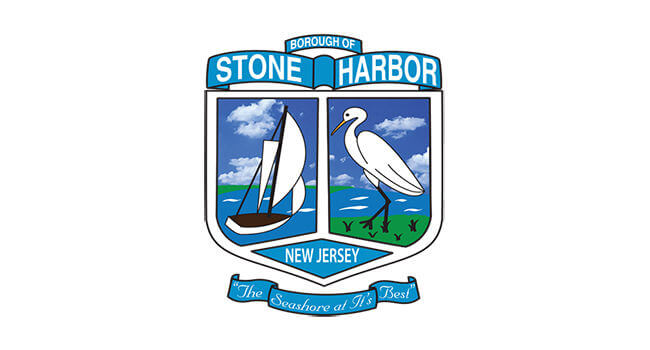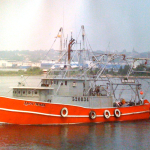STONE HARBOR – Stone Harbor Council heard details, Dec. 20, of an upcoming federal beach nourishment scheduled to begin in early 2023.
In a presentation to the council, Christopher Constantino of the state’s Department of Environmental Protection (DEP), and Eric Rourke, from the U.S. Army Corps of Engineers (USACE), explained how the beach fill would work.
It was welcome news given that the borough had been left without sand replenishment during the 2019 beach nourishment due to a ban on the use of federal dollars for mining sand from Hereford Inlet. The ban is part of a U. S. Fish and Wildlife enforcement of a 1982 federal statute, the Coastal Barrier Resources Act (CBRA).
The ban has been an on again off again restriction with an Interior Department decision during the Trump administration that temporarily lifted the ban only to see the Biden administration reimpose it. With the restriction in place, in 2023 Stone Harbor will use sand mined in Townsends Inlet and pumped most of the length of 7 Mile Island to Stone Harbor beaches. The fact that the USACE is forced to pump sand over such a distance elevates the cost to the borough which pays a municipal share for all federal nourishment projects.
The Details
The federally sponsored beach nourishment is part of a long-term agreement between the boroughs of Avalon and Stone Harbor with the USACE. The initial beach construction under this arrangement occurred in 2002 with over 2.6 million cubic yards of sand pumped onto the Stone Harbor beaches. Since then, the borough had sand replenishments in 2011, 2014 and 2017. The borough was left off the 2019 replenishment project.
The USACE issued a contract award for the upcoming replenishment on Dec. 15 with a guaranteed base amount for Stone Harbor of 464,000 cubic yards and up to four options that would increase the sand fill by an additional 350,000 cubic yards. Constantino said it was likely that the project would include three of the four options providing 250,000 cubic yards added to the base amount. The roughly 700,000 cubis yards of sand would be the largest amount pumped onto Stone Harbor beaches since their initial construction in 2002.
The project is likely to begin sometime in February and must be completed by early June. The USACE template dictates a 150-foot berm and dunes set at an elevation of 14.75 feet, or roughly seven feet above the 7.25-foot elevation of the beach.
The federal beach fills happen on a three-year cycle depending upon congressional authorization of the funds. For Stone Harbor this will be the first such project since 2017 and many of the borough’s beaches are in need of the new sand. The fact that the sand borrow area will be in distant Townsends Inlet will increase the cost significantly.
Most of the cost, usually 75%, is covered with federal dollars. Of the remaining 25%, the state picks up 75% of those non-federal costs, leaving between 8% and 9% of the total for each municipality. In the case of the 2023 replenishment the municipalities will not be paying the same price per cubic yard of sand.
Cost
The cost to Stone Harbor taxpayers for the much-needed nourishment of the borough’s engineered beaches will run approximately $2.4 million. One way of gauging the impact of the use of Townsends Inlet sand rather than the closer Hereford Inlet was the cost attached to the options in the contract. The shared cost for all of four options for the same amount of extra sand in each borough was said to be a little over $3.9 million in Avalon and a little more than $6.9 million in Stone Harbor. The difference, Constantino said, reflects the added cost associated with the cumbersome method of mining and pumping the sand the length of the island.
In a recent meeting of the Avalon Council, Business Administrator Scott Wahl said the Avalon share of the beach fill costs for the 2023 nourishment would be approximately $1.1 million. In the presentation of the Stone Harbor Council, Constantino said the cost to Stone Harbor was $2.4 million.
If those numbers hold, the increase in cost to Stone Harbor is significant. Stone Harbor is getting more sand than Avalon and should expect to pay more. Yet counting base amounts and three of the four options which Constantino and Rourke said were likely to be included for an extra 250,000 cubic yards, the sand differential, base amount plus options, between the two boroughs would be just under 50% but the cost differential is almost 120%.
Hereford Inlet
The Fish and Wildlife Service has interpreted the 1982 CBRA as barring the use of federal funds for mining Hereford Inlet sand for replenishment of beaches outside the CBRA designated areas, which include Stone Harbor’s beaches. The ban does not restrict the use of the inlet’s sand; it restricts the use of federal funds in any project that mines the inlet’s sand. Given the high cost of federal replenishment projects and the large portion of those costs covered by federal appropriations, the result is Hereford Inlet sand is unavailable for beach fill efforts.
Constantino said that some of the funds for the 2023 beach replenishment project would be directed to required studies of a potential alternative sand borrow area about two miles offshore. That might result in a new source of sand for future replenishments, but it does nothing to lower the cost associated with the 2023 project.
A brief window existed when sand from the inlet could have been used for beach replenishments north of the inlet. In late 2019 Interior Secretary Bernhardt reversed the Fish and Wildlife interpretation of CBRA and approved the taking of sand from the Hereford Inlet for beach replenishment. He said the previous decision that restricted the use of the sand was counter to congressional intent when the CBRA was passed. That position was reversed by the new administration that took office in January 2021 in response to strong pressure from environmental groups.
In a 2016 letter from Fish and Wildlife to the USACE, the CBRA statute is interpreted as requiring that “minimizing the loss of human life; wasteful expenditures of Federal revenues; and damage to fish, wildlife, and other natural resources must be associated with activities within CBRA Units.” Since the beaches of Stone Harbor are outside the CBRA unit, these factors cited by the USACE do not apply with regard to an exception for beach replenishment. With the reversal of Bernhardt’s decision by the present administration, that 2016 position is where the matter rests.
Stone Harbor will pay more for its sand. The USACE and the DEP will use project funds to study the potential use of an alternative sand borrow area for the future. The inlet will continue to receive more sand than it needs from the natural southerly flow of the waves, negatively impacting navigation in Hereford Inlet.
In short order the sand mined from Townsends Inlet will find its way to Hereford Inlet with a brief sojourn on Stone Harbor beaches.
Middle Township – I’m not religious, but I do believe there are better choices than abortion.








